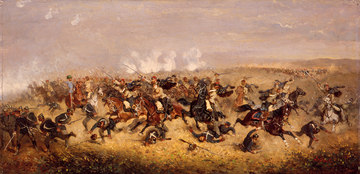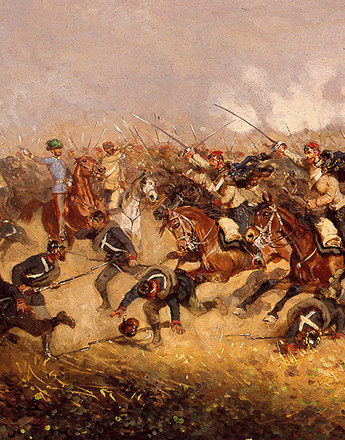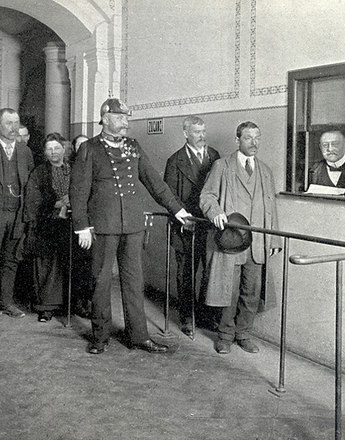From the Theresian reforms to the battle of Königgrätz
The systematic promotion of the military began under Maria Theresa and was to make it in the following decades into a commanding instrument of power. The wars with revolutionary France marked a new development in militarism, which also affected the Habsburg Monarchy.
The reforms by Empress Maria Theresa (1740–80) and her successor Joseph II (1780–90) were an important step in the militarisation of the Habsburg Monarchy. After Austria had lost Silesia to Prussia with its more organised army in the First Silesian War (1742), Maria Theresa initiated a comprehensive reform of the state and administration. It was aimed in particular at renewing the tax and military structures based on the model of the victorious arch-rival Prussia. The military was systematically developed to become a commanding and loyal instrument of power. It was entrusted with tasks such as the surveying and mapping of the empire, population census and continuous updating of the information received. The census now formed the administrative basis for conscription, the recruiting system introduced in 1770–71 in the Austrian-Bohemian core lands. The various regiments were allocated recruiting districts, from which they could press-gang the local population to enlarge their ranks. In this matter, the local power elites had no possibility of intervening. The census counted the male subjects and classified them by profession or trade. This made it possible to identify members of social strata whose social and economic status made them dispensable and available for recruitment to the standing army. The conscription system was thus highly selective. Higher social strata, men with property and/or education were exempt from the unpopular military service. In spite of these exemptions, the number of men required to perform military service rose steadily. In 1780, for example, around 40 per cent of the male population were deemed eligible.
The process of social militarisation was thus twofold: first, a large section of the population was required to do military service, and second the institution of the military was entrusted with important tasks beyond its purely military ones.
A further stage in militarisation began with the First Coalition War (1792–97) against revolutionary France, which had embarked on a course of total mobilisation to combat the counterrevolutionary forces in Europe. The French national guard was at the origins of the “citizen soldier”, who went to war not through coercion or economic self-interest but through inner conviction. The French national guards of the Volontaires Nationaux fought for the reforms achieved by the Revolution. For that reason – and unlike their conscripted colleagues – they were highly motivated to fight.
The total mobilisation and soldierly drive of the French made an impression and became the model – albeit under completely different circumstances – for the universal conscription introduced by Prussia in 1814, from which time all fit men had to perform military service. Prussia demonstrated that mass mobilisation could take place without concessions to liberalism: the authoritarian state wanted to motivate its soldiers for the “national cause”.
The effectiveness of the Prussian system was painfully demonstrated to the Danube Monarchy at the battle of Königgrätz (1866). The defeat revealed how far it lagged behind the Prussian army – not only in terms of equipment. Following the defeat, Emperor Franz Joseph ordered a sweeping reform of the army, which had far-reaching consequences for society within the Habsburg Monarchy through the introduction of universal conscription in 1868.
Translation: Nick Somers
Hochedlinger, Michael: Militarisierung und Staatenverdichtung. Das Beispiel der Habsburgermonarchie in der frühen Neuzeit, in: Kolnberger, Thomas/Steffelbauer, Ilja/Weigl, Gerald (Hrsg.): Krieg und Akkultuaration, Wien 2004, 107-129
Kruse, Wolfgang: Bewaffnete Bürger. Die Nationalgarde in der Französischen Revolution, in: Bergien, Rüdiger/Pröve, Ralf (Hrsg.): Spießer, Patrioten, Revolutionäre. Militärische Mobilisierung und gesellschaftliche Ordnung in der Neuzeit, Göttingen 2010, 235-258
-
Chapters
- Militarisation and nation-building: an interaction
- From the Theresian reforms to the battle of Königgrätz
- Universal conscription as the fundamental militarisation of society
- Military training: violence as a military instrument for achieving obedience
- Suicide, questions in parliament and pathological military discourse
- Anti-militarism in Bohemia: “The fit are enslaved”
- Total mobilisation – the First World War and special measures






